Table of Contents
Competitive analysis is a major part of any comprehensive market analysis. It allows you to gather information about your competitors, assess their strengths and weaknesses and helps you build strategies to improve your competitive advantage.
In a competitive analysis, there are many areas to look at and examine. In this list, we have covered how to do a competitive analysis using several competitive analysis techniques that you can use during each phase of your competitor research and competitive analysis.
What is a Competitive Analysis?
A competitive analysis is a central part of a marketing plan. Information gathered from a competitive analysis helps you identify what makes your product or service unique from that of your competitors. Using that data you can develop strategies to attract your target market.
Competitive analysis is the process of identifying and evaluating the strengths and weaknesses of a business’s competitors to understand the marketing landscape and improve one’s strategy. This involves analyzing the competitors' products, pricing, marketing strategies, customer base, and other relevant factors. Businesses can adapt and develop in ways that set them apart from their competitors and appeal to customers in new ways by studying how their competitors operate and what differentiates them. The main objective of a competitive analysis is to identify opportunities and threats within a particular market or industry and to use the information to make informed decisions to gain a competitive edge in the market.
Importance of Doing a Competitive Analysis
There are several reasons a business would opt to conduct a competitive analysis. They are,
- To identify market opportunities: Businesses can identify gaps and opportunities for market growth by understanding competitors' strengths and weaknesses. This can help businesses develop new products/services that target unmet customer needs or find new ways of differentiating themselves in the market.
- To gain a competitive advantage: Businesses can identify ways to differentiate themselves from their competitors and gain a competitive advantage. This can include offering better pricing, improving product features, or developing more effective marketing strategies.
- To better understand the market and customers: By analyzing the competitors, businesses can understand and gain insight into customer preferences, market trends, and emerging technologies or products.
- To anticipate and mitigate potential threats: By analyzing the competitors and the market, businesses can forecast potential threats to their market position and take steps to mitigate them. For example, if a competitor is known to lower prices, a competing business can focus on offering a high-quality product.
- To benchmark performance: Businesses can also benchmark their performance against competitors through a competitive analysis. By comparing metrics such as market share, revenue growth, and customer satisfaction, businesses can identify areas where they are outperforming their competitors and areas where they may need to improve.
- To improve decision-making: A competitive analysis can provide valuable insights to inform business decisions, including product development, pricing, marketing, and sales. Businesses can enhance their performance by using this information to make informed decisions.
How to Do a Competitive Analysis with Visual Techniques
A competitive analysis depends on competitor information about several areas. You can use the following competitor analysis techniques to gather and analyze the different types of data.
- Identify and categorize top competitors
- Analyze competitive landscape
- Analyze competitors’ market positioning
- Conduct a competitive intelligence analysis
- Compare competitor products and prices
Identifying and Categorizing Top Competitors
Before you start comparing your product to those out there, you need to know who you are competing with. There are several methods you can use to research and identify your competitors.
- Search on Google, Bing etc. for your product name, product idea or related keywords
- Search on social media channels and online communities
- Ask your colleagues or other experts in the field
- Ask from your potential customers via emails, surveys etc.
Categorize Your Top Competitors Using a Mind Map
Once your research is done, you may have a pretty long list of the names of direct, indirect, potential etc. competitors.
It’s important to categorize them, so you know which competitors to prioritize. A simple mind map like the one below can help you with that.
You can also categorize them as primary competitors, secondary competitors and tertiary competitors on the mind map.
You can further expand the mind map to include their location, website URLs (click the relevant shape and add link) and other necessary information as well.

Analyzing Competitive Landscape
Next step is to analyze the competitive landscape. Here you should focus on understanding the strengths and weaknesses or your competitors and threats and opportunities in the industry and find opportunities for growth.
SWOT Analysis
SWOT stands for Strengths, Weaknesses, Opportunities, and Threats. Use it first to analyze your own product.
Look into what your strengths and weaknesses are. These are your product’s positive attributes like resources, unique product features etc. and negative attributes like inefficient processes, lack of resources etc. These are within your control.
Opportunities are technological advancement, growing market demand etc. And threats could be negative economic and political change. These are external and therefore are out of your control.
You can do a SWOT analysis for your competitors as well to learn how they are surviving in the market.

PEST Analysis
The PEST analysis looks at external factors that affect a product or service. Namely, they are Political factors, Economic factors, Social factors, and Technological factors.
By gathering this information you can determine how your competitors will behave in the face of changes occurring in these areas. You can alter or develop your strategies accordingly.
PESTLE is the extended version of PEST, as it takes Legal and Environmental factors into consideration as well.

Porter’s Five Forces Analysis
Porter’s five forces analysis examines the environment in which a product operates. It helps to understand the level of competitive intensity in the industry. It primarily examines five factors in the industry
- Suppliers
- Buyers
- Entry/Exit Barriers
- Substitutes
- Rivalry
By examining these factors you can determine the profitability and the attractiveness of an industry. Refer to our List of Marketing Strategy Planning Tools to learn how to use Porter’s five forces analysis along with 13 other tools to plan your marketing strategy.
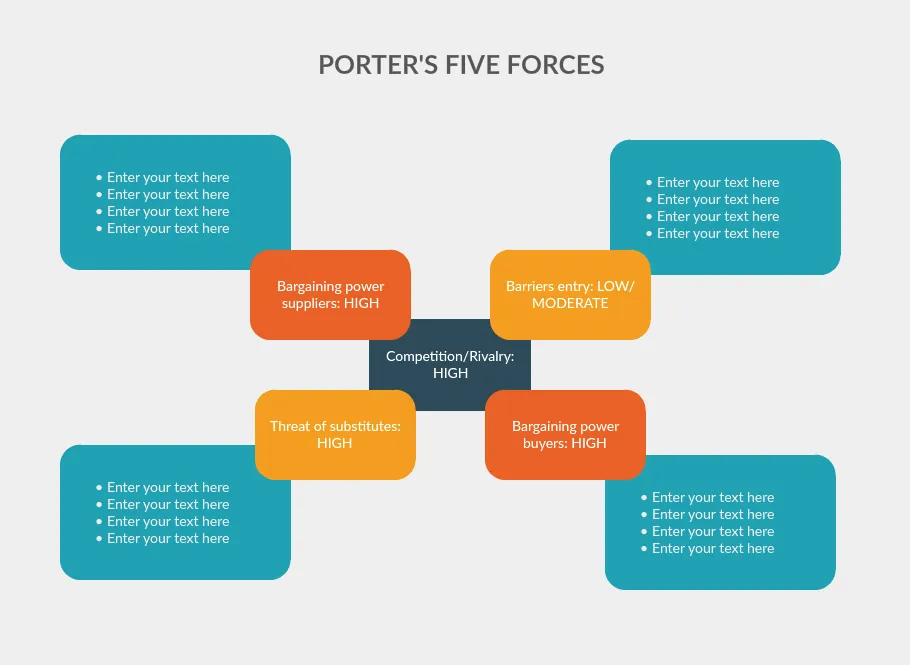
Analyzing Competitors’ Market Positioning
This is where you try to evaluate the ability of your competitors to influence the perception of their consumers (who also belong in your target audience). In other words, here you’ll be looking at how your customers perceive the products of your competitors as well as that of yours.
Value Proposition Canvas
Value proposition canvas is a tool used to develop products that match the needs of customers. It is made up of the customer profile and value proposition of the business.
Customer profile consists of
- Gains: the gains the customers expect and wish to attain
- Pains: the negative experiences the customer has to go through when doing their job
- Customer jobs: the tasks the customers are trying to perform or the problems they are trying to solve
Value map consists of
- Gain creators: how the product offers added value to the customer
- Reliever: how the product can relive the pain of the customer
- Products and services: the products and services that create gain and relieve the pain of the customer
Value proposition canvases based on your competitors will help you figure out how they are offering value to their customers.
Refer to our Guide on Launching a New Product to learn how to use the value proposition canvas step-by-step.
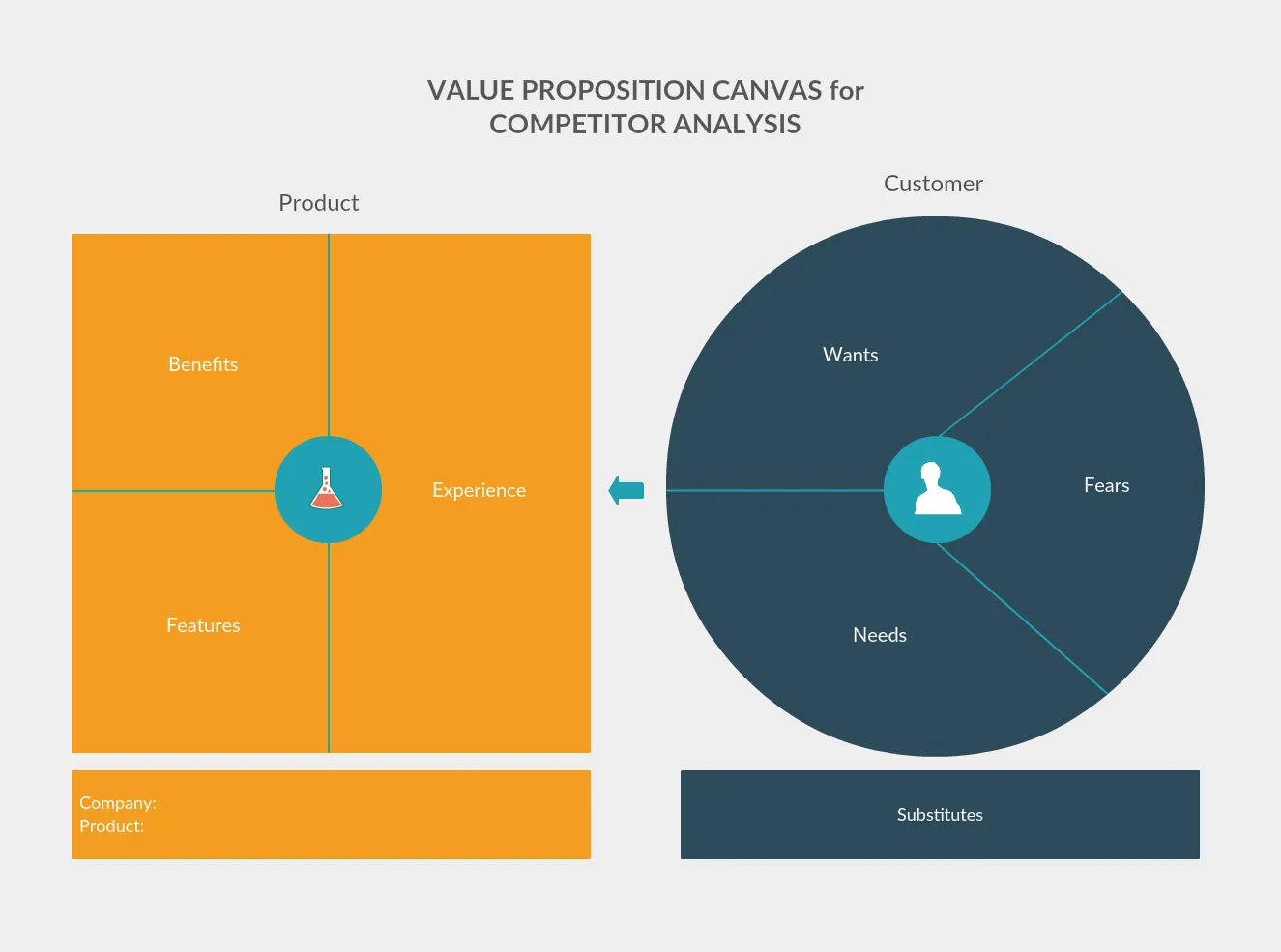
Perceptual Map
The perceptual map helps you identify where your competitors are positioned in relation to your product’s position. It helps you understand what the average target market consumer thinks of your product and those of your competitors.
How to do it
Step 1: Select two determinant attributes you want to compare your competitors against. These determinants are the attributes consumers depend on to make decisions. For example, it could be the quality of the product and the price of it.
Step 2: Gather your list of competitors in the product category. From the mind map of competitors, you created earlier, pick 5 to 10 players in the first category.
Step 3: Based on a 1 to 5 rating scale, give scores to each selected competitor using the two determinant attributes.
Step 4: Using the grid, assign a place for each competitor. This will help you get a quick overview of where each and every competitor stand compared to one another.
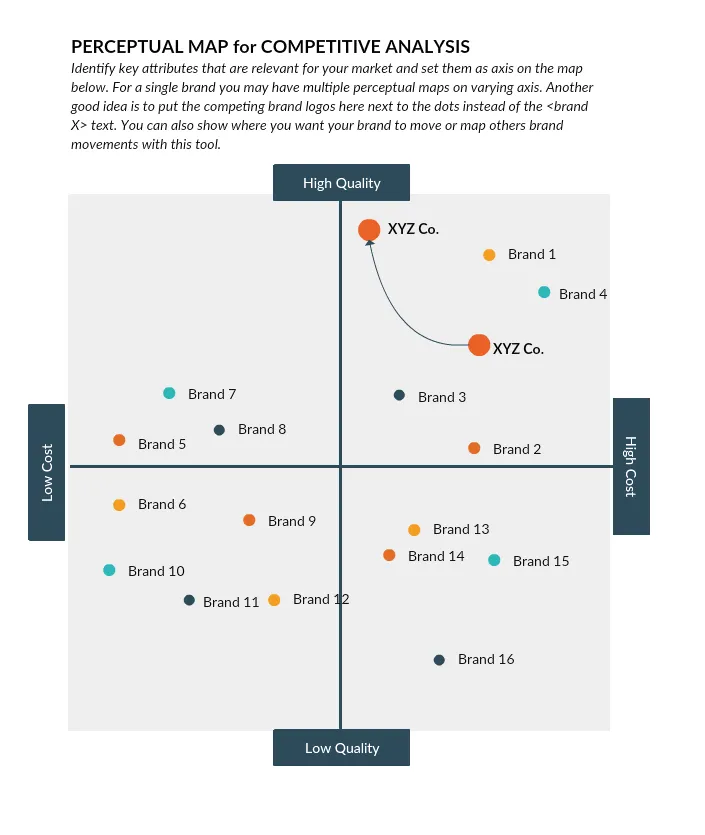
Conducting Competitive Intelligence Analysis
Competitive intelligence analysis is the process of gathering and examining data on competitors, their products and customers, and target markets.
The synthesized data you generate through the analysis can be used by internal sales and marketing teams to make better decisions and develop strategies.
How to do it
Step 1: Conduct research to gather data on your competitors. You can rely on resources like the customers, websites, social media, analyst reports, press releases, demo videos etc. to find information on your competitors, their customers etc.
Step 2: Use a mind map like the one below to organize and categorize the data you’ve gathered

Step 3: Sort through and analyze all the data and create a competitor profile that covers aspects such as products, market, sales, partners, etc.
Step 4: You can use a competitor profile like the one below to organize information and save them for later use and share it with your internal teams that need to come up with strategies to counter your competitors.
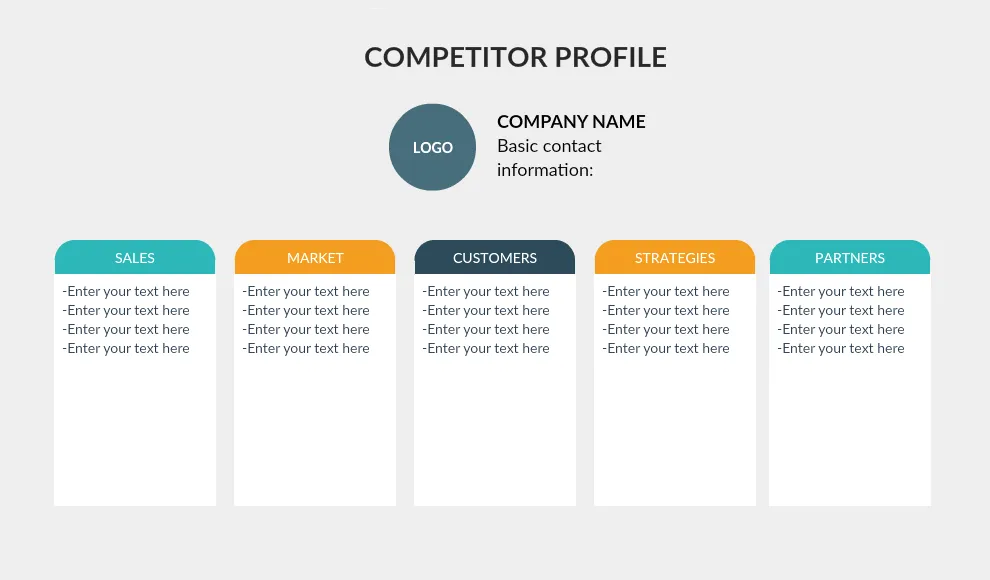
Comparing Competitor Products and Prices
When developing new product features or outlining your pricing strategy, you need to take into consideration your competitors and how they have managed to deliver to their customers so far.
Radar Chart
A radar chart is a tool that you can use to compare the products of your competitors based on different characteristics. It will help you identify which competitors are scoring high or low within the characteristics you’ve selected.
Step 1: Select the competitors you want to compare and assign them an axis that starts from the center.
Step 2: You can either select one characteristic and compare several competitors to evaluate their performance, or you can take one competitor and evaluate how they score under several characteristics.
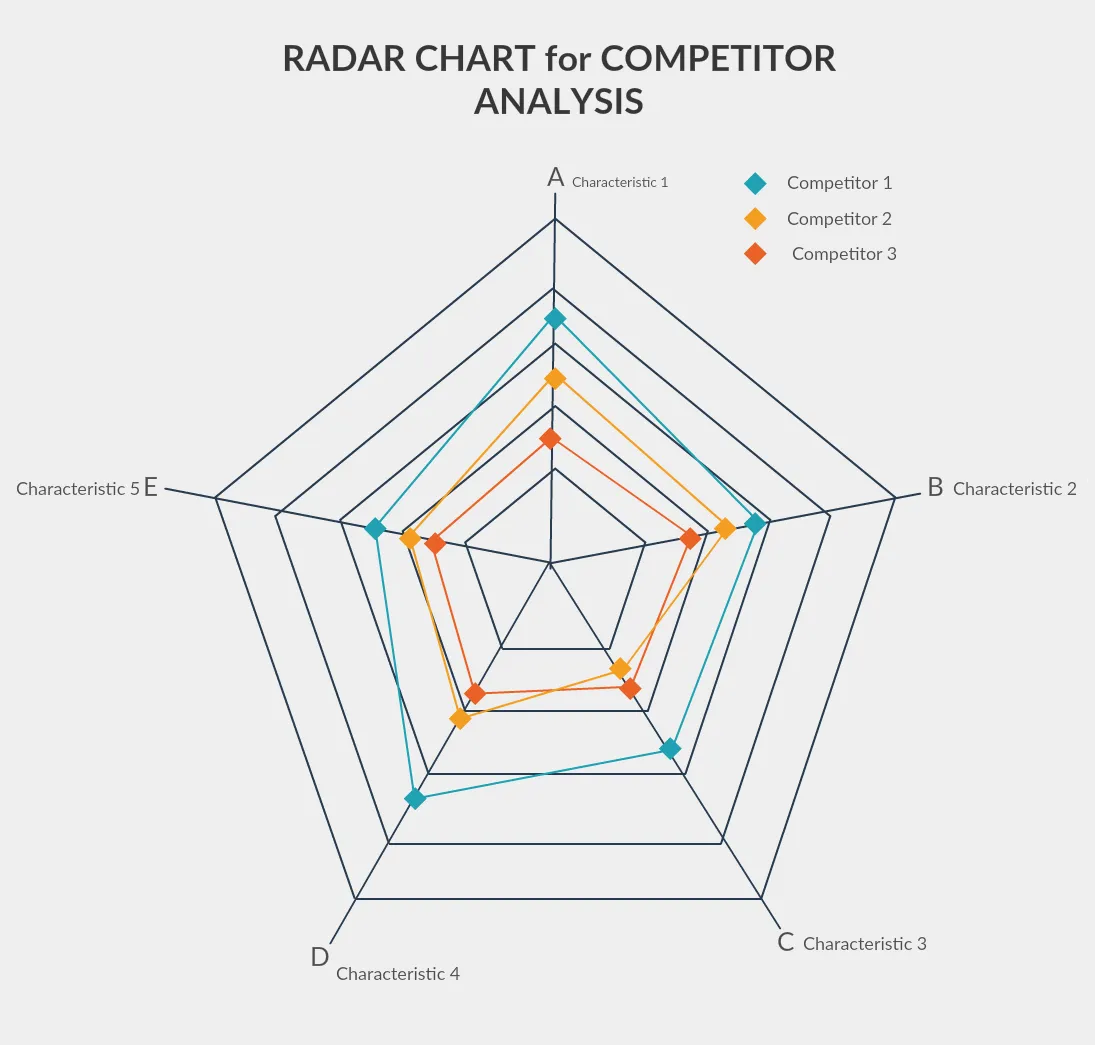
Compare and Contrast Charts
Compare and contrast charts are a great visual tool to compare products. It will offer a quick overview of the capabilities of competitor products and that of yours when you are planning strategies or new developments.
Whether you want to compare product features, prices, or characteristics of competitor marketing strategies, generate compare and contrast chart and it is a great way to organize and analyze information.
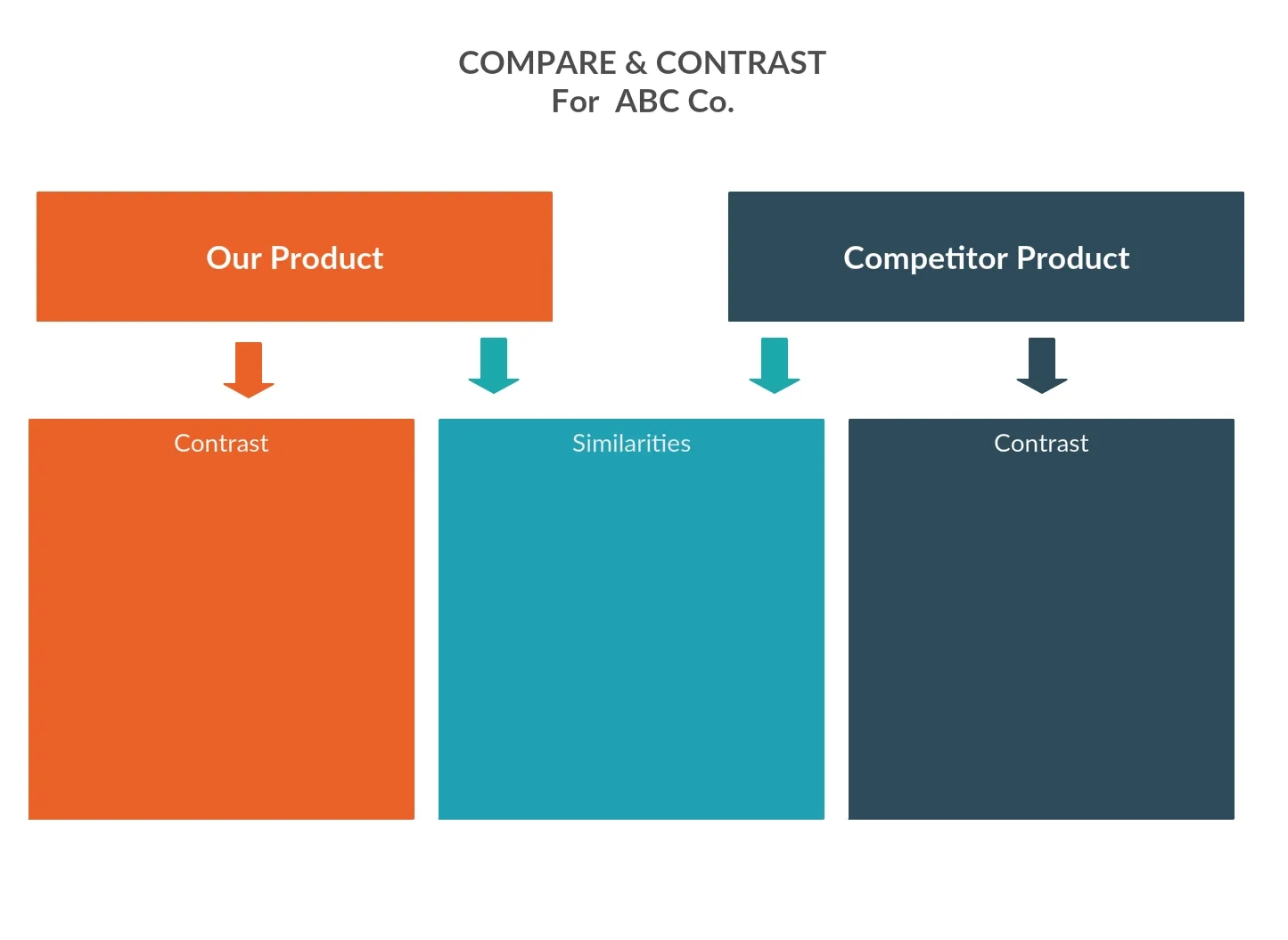
Competitor Price Analysis
With a chart like the one below, you can rate your competitors based on their strengths and whether increasing or reducing your product price is too costly or profitable for you.
How to do it
Step 1: Research and gather price information of your top competitors
Step 2: Figure out whether reducing or increasing your product’s price to gain a competitive advantage over your competitors would cost you too much or help you make profits
Step 3: Use the grid below to visualize your findings and find which price reaction you should take in order to make a profit.
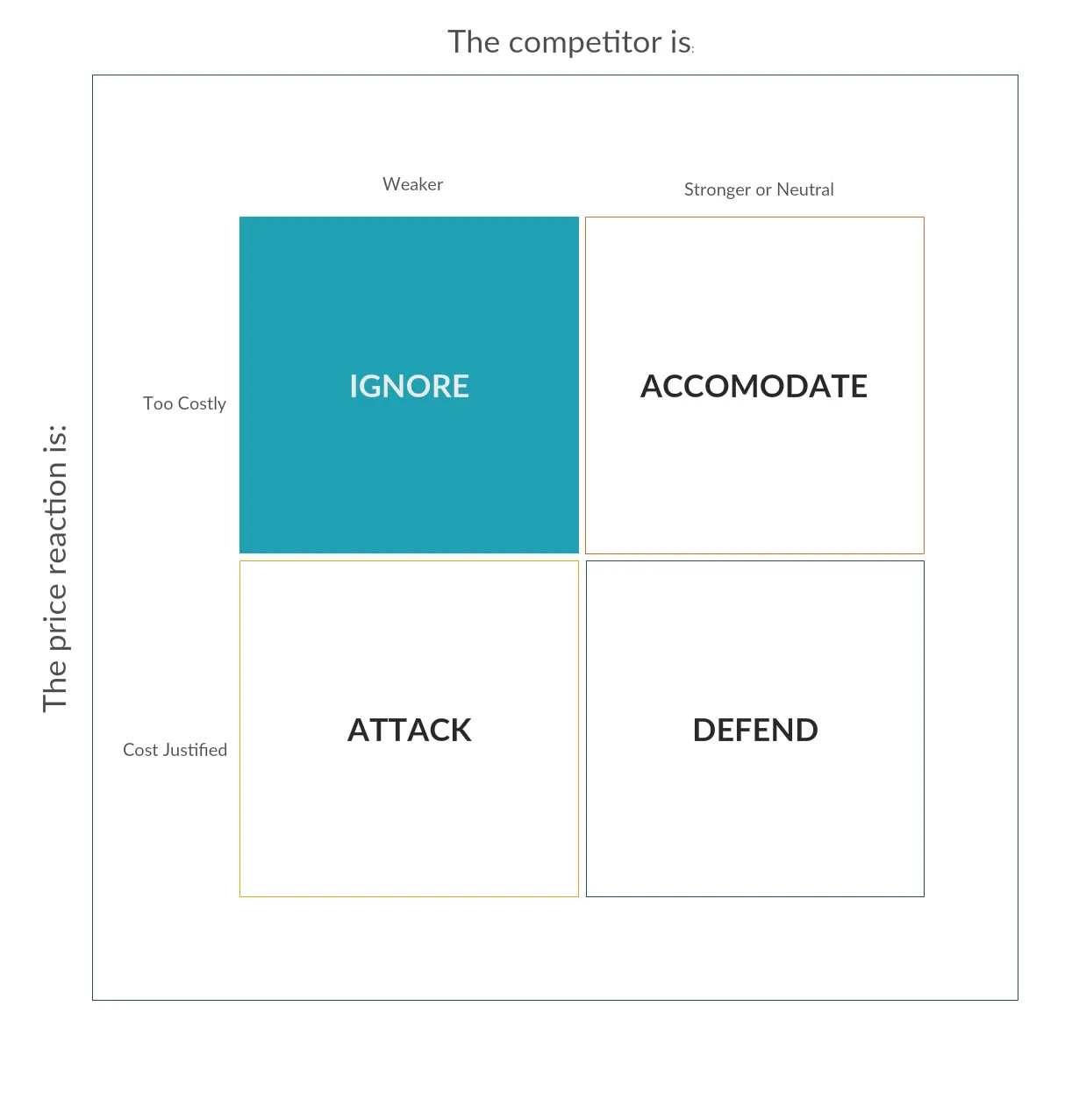
Read this article to learn how to use a standard competitive price response analysis in detail.
When to Use a Competitive Analysis
- To assess entering the market: If a business is considering entering a new market, a competitive analysis can help them to understand the competition and determine whether there is an opportunity to differentiate themselves.
- To identify product development opportunities: Competitive analysis can help a business identify gaps in the market and develop products that can fulfill the gaps in customer needs or offer unique features that set them apart.
- To determine the pricing strategy: By analyzing the competitors’ pricing strategies, businesses can develop more effective pricing strategies that reflect the market and offer competitive value to customers.
- To determine the marketing strategy: By conducting a competitive analysis, businesses can develop more effective marketing strategies highlighting their unique value proposition and differentiating them from their competitors.
- To determine the sales strategy: By understanding the sales strategies of their competitors, businesses can identify opportunities to improve their sales processes and better serve their customers.
- To create partnerships and collaborate: Competitive analysis can help identify potential partners or collaborators in the market and understand how these relationships can benefit the business.
Common Mistakes and How to Avoid Them
Try to avoid the below mentioned mistakes when you are conducting a competitive analysis.
Focusing too much on the competition
It’s critical that you remain focused on your own business and not get caught up in what your competitors are doing. It is of course important to understand your competition, but it should not be the only factor influencing your company’s decisions. Rather, a competitive analysis should provide you with insights in the market and actions of your competitors. Make sure to balance your competitive analysis with your own strengths and goals.
Failing to consider indirect competitors
Due to the fact that they provide alternatives or substitutes for your goods or services, indirect competitors can be just as significant as direct ones. Even if they are not direct competitors, make sure you include any relevant competitors in your research.
Relying on inaccurate, outdated or incomplete information
A competitive analysis is only as good as the information it is based on. Make sure you are gathering accurate, up-to-date and complete information from reliable sources. Double-check your data and update your analysis regularly.
Not prioritizing key factors
When conducting a competitive analysis, it is critical to give priority to factors that are most important to your business. For instance, if pricing is an important aspect for your business, make sure you prioritize gathering and analyzing pricing information from your competitors.
Not developing an action plan
A competitive analysis is only useful if you use the insights gained to inform your business decisions. Therefore, make sure to develop an action plan based on the findings of your analysis and to set clear goals and objectives for your business.
Not carrying out keyword research of tracking Google search rank
Keyword research and tracking Google search rank can give you valuable insights into how your competitors are positioning themselves in the market and what keywords they are targeting. Make sure you include this information in your competitive analysis.
Not keeping up to date with industry news or trends
The market can change quickly, so it’s important to stay up to date with industry news and trends. Make sure you regularly check industry publications, news websites and social media for relevant updates.
Not updating the competitive analysis regularly
A competitive analysis is not a one-time event but an ongoing process. Make sure you update your analysis regularly to stay current with changes in the market and your competitors' activities.
Not getting relevant stakeholders involved
Make sure you involve relevant stakeholders, such as marketing, sales, and product development teams, in the analysis process and share the findings with them. This can help to align everyone around a common understanding of the market and competitors, and facilitate collaboration towards shared goals.
What are Your Thoughts on How to Do a Competitive Analysis?
In this list, we’ve covered visual techniques that you can use to research competitors, analyze the competitive landscape and competitors’ market position and more.
These visual competitor analysis tools help you organize the data you collect and make effective decisions about how you should position and market your product or service.
Have you got any other competitive analysis techniques to add to the list? Leave your thoughts in the comment section below.





